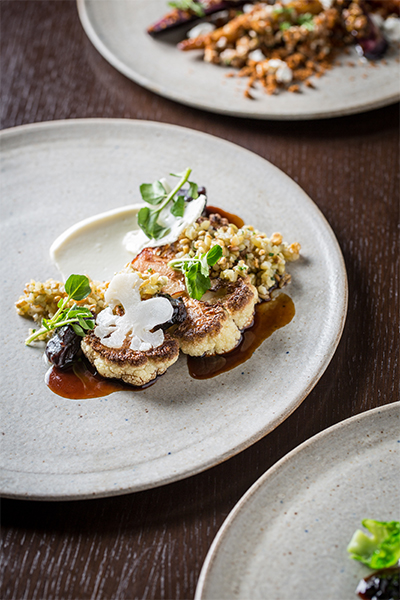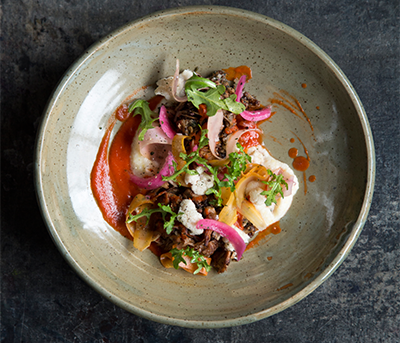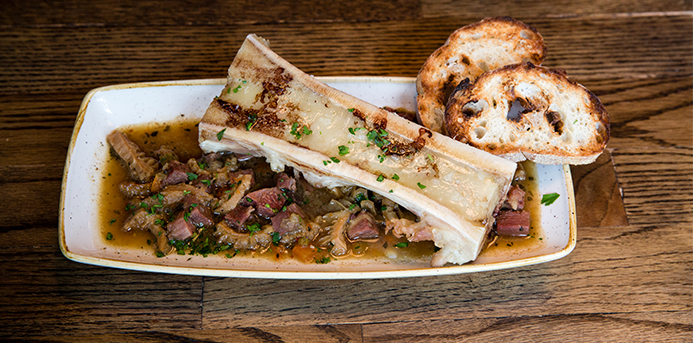When an ingredient explodes in popularity, even a casual diner picks up on the trend. Suddenly avocado toast replaces French toast on breakfast menus and it seems like every salad is made with massaged kale. The culinary world can be a finicky one to forecast, but we are making a studied guess about some items you might be seeing more of soon at a restaurant near you. Pork belly may never be totally passé — it’s simply too delicious — but next time you’re dining out, keep an eye out for these five ingredients.
Tripe
The gelatinous honeycomb texture and the thought of eating cow’s stomach might put some diners off from this cut of meat, but it’s truly delectable. Many taquerias and traditional Mexican restaurants serve menudo, a spicy soup made with cow’s stomach, but now some of our favorite Italian restaurants are offering traditional and contemporary versions. At Osteria Langhe, Chef Cameron Grant’s braised tripe with mirepoix is one of the cozy Italian restaurant’s bestsellers, topped with chili flakes and served with grilled bread. Grant first fell in love with tripe in Italy and made the traditional Piemontese dish his own by adding beef tongue and bone marrow. “All the undesirable characteristics melt away when loaded with aromatics and a long cook time,” Grant says. “It is always a treat as a chef to transform a humble cut into gold.” Another Italian-inspired tripe preparation is available at Nico Osteria. Chef Erling Wu-Bower braises tripe in a spicy tomato sauce with chickpeas, kale and fried egg for his Trippa Alla Romagna. “It’s one of my favorite dishes on our breakfast menu,” he says. “Tripe is delicious and the Romans know how to do it best.”
Goat’s Milk

Goat’s milk can be a great alternative to cow’s milk for people who have allergies or sensitivity to dairy. Although it contains lactose, goat’s milk is more easily digestible and doesn’t contain the alpha S1-casein protein that some are allergic to. Chef Andrew Pingul wanted to put a crumb cake on the brunch menu at Cantina 1910 and, to make this pastry stand out, he fills it with housemade cajeta, a Mexican caramel sauce. Pingul uses goat’s milk from LaClare Farms in Malone, Wisconsin, to add a rich, earthy note to the caramel syrup. “Its flavor is distinct and slightly more aggressive [than cow’s milk],” Pingul explains. At newly opened Oriole in the West Loop, Pastry Chef Genie Kwon makes yogurt from goat’s milk, then blends it with cajeta for a tangy, caramel-y accompaniment to her Gianduja Palette with banana and lemon. “The light, creamy, slightly acidic and tangy quality of goat’s milk helps balance the richness of the chocolate,” Kwon says. (Editor’s note: Cantina 1910 closed in August 2016.)
Chermoula

This light herb sauce is the North African equivalent of chimichurri, made with cilantro, parsley, garlic, olive oil and lemon juice. A new seared scallop dish on FIG & OLIVE’s spring menu features housemade chermoula with their famous extra virgin olive oil. The bright fresh flavor pairs nicely with honey heirloom carrots, carrot-orange puree and roasted orange segments. At Salero in the West Loop, chermoula is served with grilled Atlantic swordfish accompanied by fennel and potatoes cooked with oil-cured black olives, capers and preserved lemon. “We were inspired to focus on the briny aspects of Mediterranean cuisine,” says Chef Ashlee Aubin. “All of these assertive flavors get tamed by the sweet, starchy vegetables and the oily grilled fish, but the dish still needed a top note of spice and herbs. The chermoula contrasts the briny ingredients with its fresh flavor.” Try this versatile sauce at home drizzled over grilled meat or seafood. Aubin recommends heavily toasting the spices. “Let the edges of the cumin get a little dark,” he says. “Grind them with a mortar and pestle to really make the flavor pop.”
Freekeh

You can now find this ancient Middle Eastern grain at a grocery store near you, while a couple years ago it was only available in specialty food markets. A couple months ago, Chef Lee Wolen at Boka switched from quinoa to freekeh to accompany his charred cauliflower steak, also garnished with prunes and goat gouda. “I like the texture of freekeh better,” he says. “It is a bit crunchier and has more flavor. I love that freekah is so versatile. You can cook it in so many different ways, for instance in a risotto, or puffed, or boiled, which each give it a different texture.” At White Oak Tavern in Lincoln Park, Chef Tom Van Lente is experimenting with freekeh too, planning a new spring dish with grilled asparagus, freekeh, egg and pecorino. “I’m pretty unfamiliar with freekeh but excited to give it a try,” he says. “I think the crystallization of the cheese will really be a great pairing. I think some grilled oranges would be a nice way to introduce some acid too. It’s practically breakfast but in a pretty original way that most people have never experienced.” Van Lente is also thinking about a freekeh dish with fava beans, peas, mint and chilies. “I think the roasted grain will be a great vehicle for all the great spring produce.”
Jackfruit

Chef Edward Kim first tried jackfruit while traveling in Thailand last year and was impressed with the tropical fruit’s versatility. It tastes a little like bubble gum when it’s ripe and unripe jackfruit is used in India to make spicy curries. Kim braises the unripe green fruit at Ruxbin in red wine seasoned with cumin and Mexican spices for Jackfruit Carnitas, served with stone-ground grits, smoked tomato and escabeche. “It has a fibrous heartiness that can be used as a meat substitute,” Kim says. “I also overheard they are learning how to grow it in the U.S., so it will be easier to source in the future.” Pastry Chef Jesse Divine works with ripe fruit in desserts at Roka Akor. For an upcoming Chef Week menu (running Sunday, April 17 – Friday, April 22), he will serve the fruit fresh and as a sorbet with tempura-fried raspberry mochi skin, caramelized red bean miso and banana. “I usually find my jackfruit at one of the [Asian grocery] shops around Argyle and Broadway,” Divine says.
More from Make It Better:

